
Arpitha Reddys Vishwam at the Kalakriti Art Gallery in Hyderabad is about collecting beautiful deities made in the temple mural style of Guruvayoor Kerala with contemporary elements. As you enter the portals of the gallery with these gleaming deities, you are drawn into a universe of devotion and favors.
Above all, this exhibition is about the beauty of forms, the beauty of decorative adornments and the importance of the gods and nature and how they thrive and beat in the lush bosom of Prakriti. As humans, we are given lessons in the preservation and preservation of the Earth that we have forgotten in the races within races of human egos and nations.
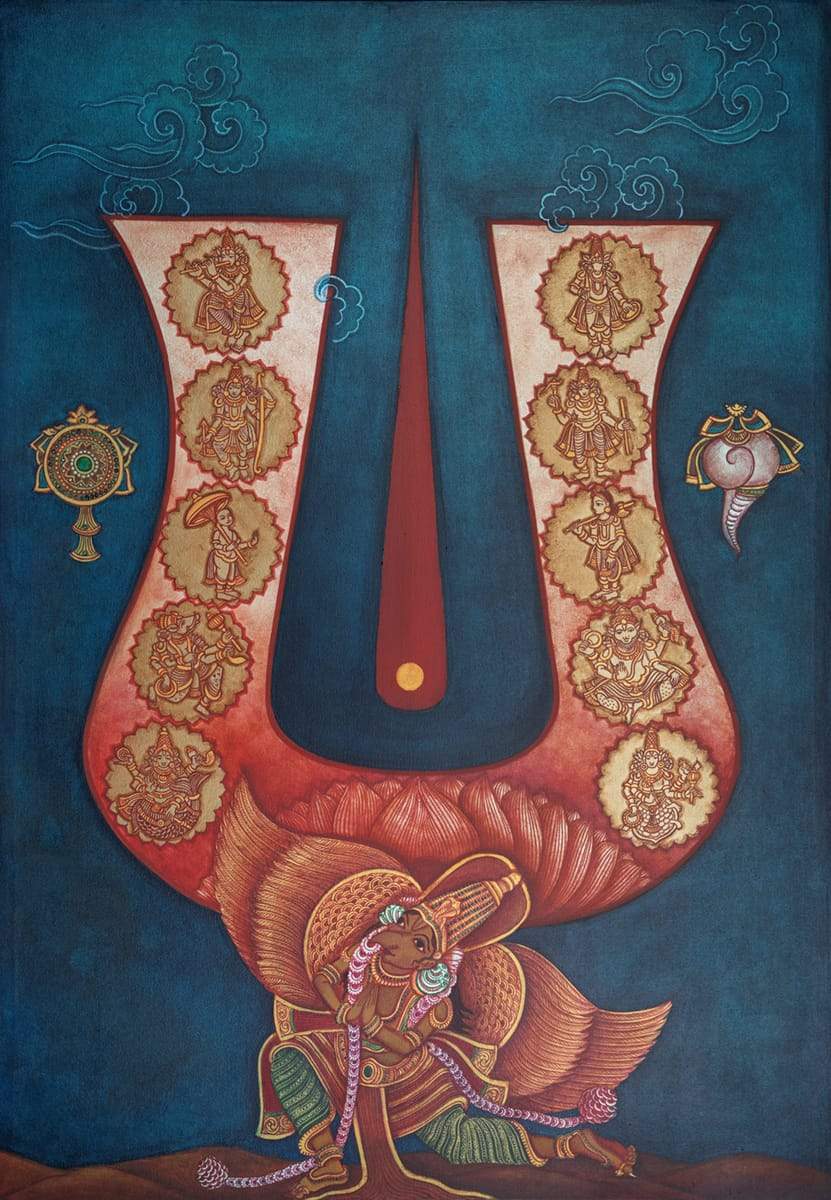
Yugantara and ten incarnations
Integral and imperative is the Yugantara image. Crested in the sacred Namam tilak, worn by devotees, one of the most evocative portraits is that of Yugantara, a powerful representation of the eternal presence of Lord Vishnu through his ten incarnations, the Dashavataras. Arpitha says that the Namam, a revered symbol associated with Lord Vishnu, acts as the focal point and embodies the cyclical nature of existence: creation, preservation and destruction.
Each avatar of Vishnu within the Namam signifies his divine intervention in different Yugas (cosmic ages) to protect the dharma and restore balance to the universe.
The most beautiful is the Garuda, the mighty celestial vahana of Lord Vishnu, who carries the Namam embedded with the Dashavataras. Its powerful wings and majestic shape symbolize unwavering devotion and the strength needed to uphold the cosmic order. Garuda’s presence in Yugantara is not merely a vehicle but also a protector and facilitator of the divine will, reflecting his deep connection with Lord Vishnu and his role in the preservation of righteousness.
The combination of the Namam, with the eternal avatars of Vishnu and Garuda, encompasses the eternal divine grace. It serves as a timeless reminder of the intertwined cycles of life, the preservation of dharma and the assurance of Lord Vishnu’s protection of yugas.
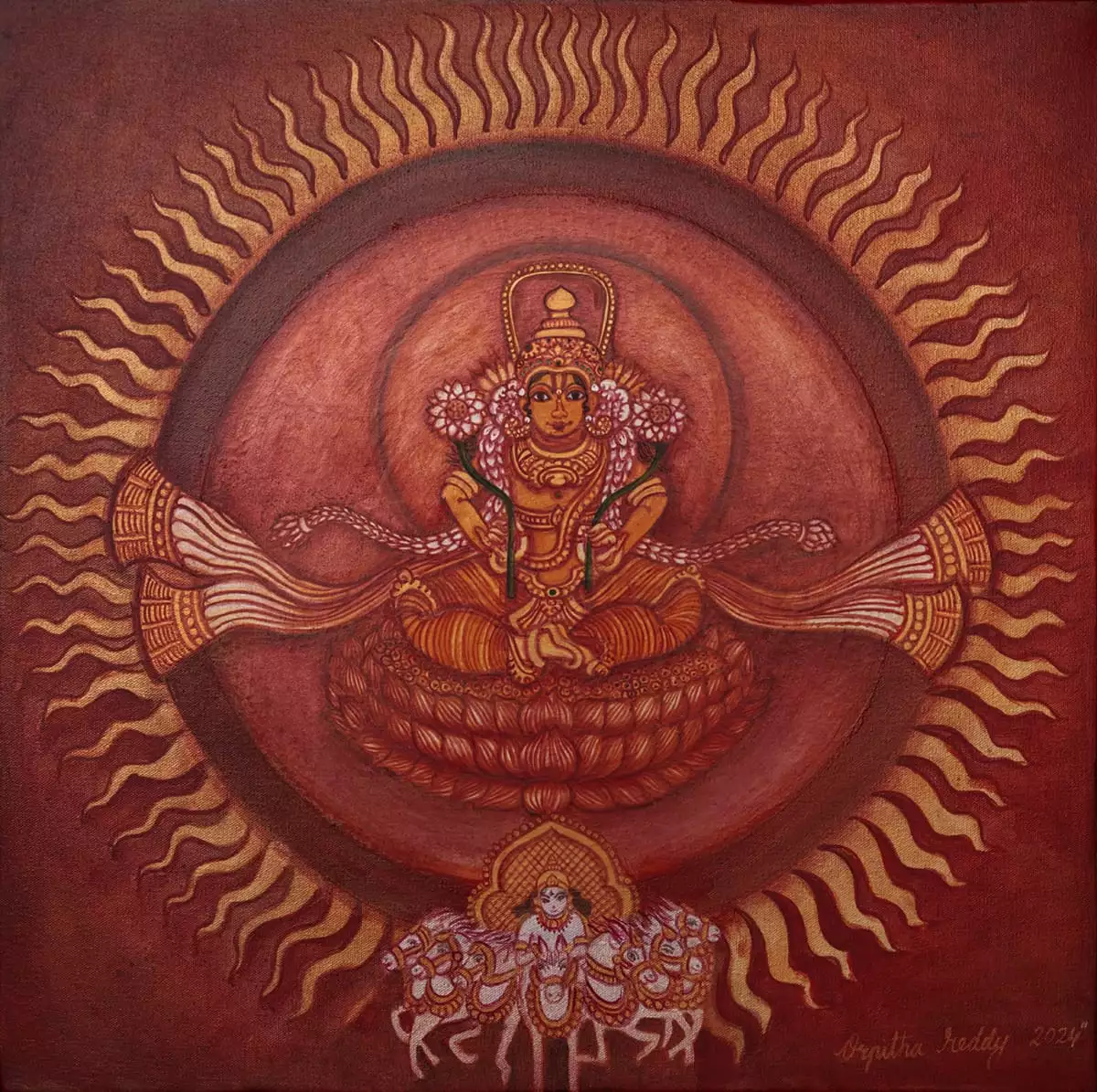
Surya Chandra
from Arpitha Surya And Chandra are depicted in a mandala. Surya the sun god is depicted with burnt terracotta rays outlining the concentric swirl Chandra is depicted against blue clouds belonging to the elements of Buddhist thangkas. Both images have gods on lotuses. The color connotations add to the depth of the metaphorical associations of both the sun and moon. Contrasting color tones alternate warm and cool tenors, creating their own rhythms of the earth. The ecological echoes of the sun and moon create their own kinetics.
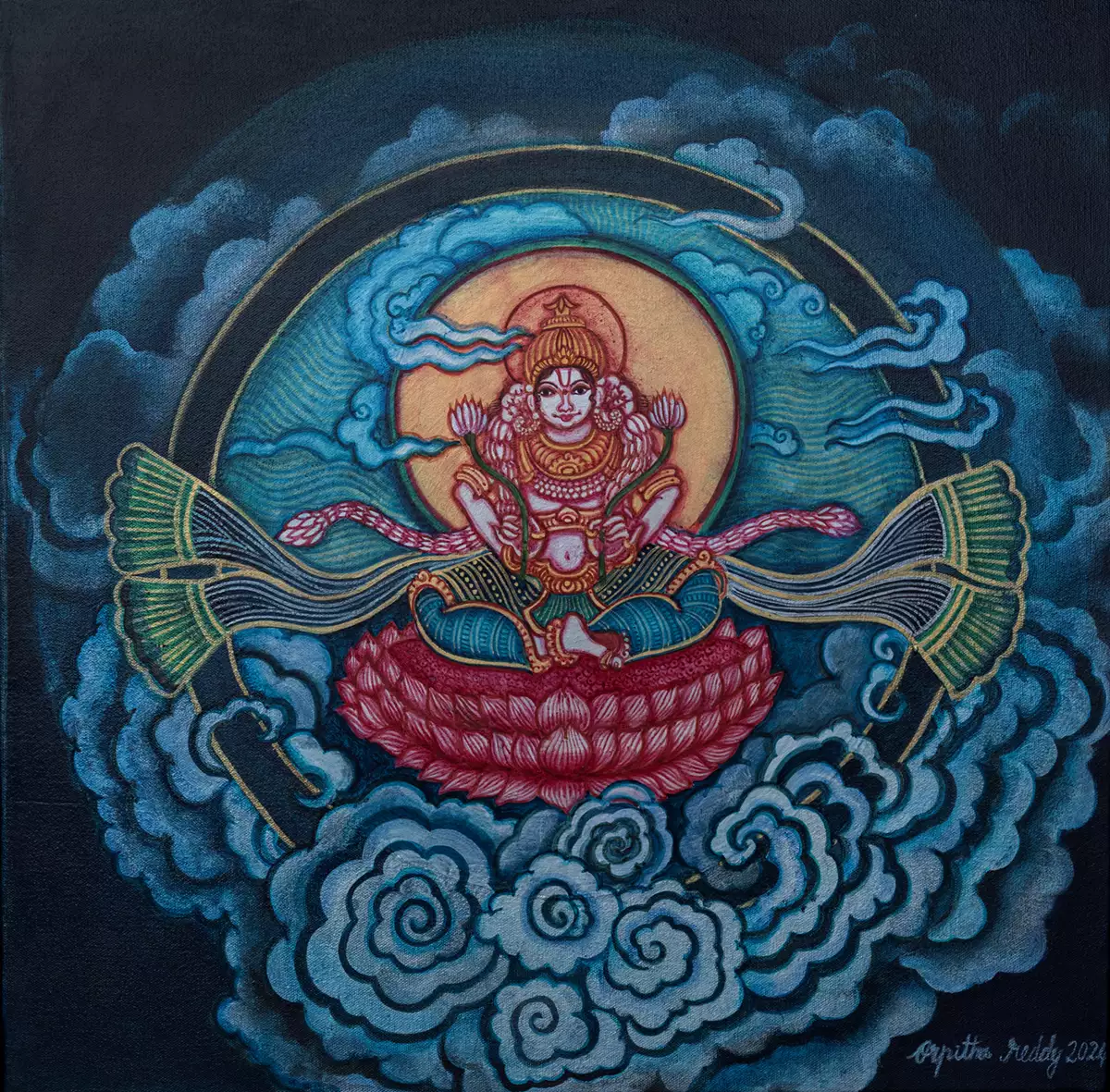
Lord Vishnu
Here in many avtaars, as well as the witness of the universe, Lord Vishnu is emphasized as omnipresent in nature and belongs to cycles of creation and dissolution. Three versions in subtle shades create their own resonance of sacred symbolism.
Lord Vishnu reflects qualities of divinity. Always embellished with beautiful garlands, bright colors created in both lyrical and linear rhythms, it is always presented with a halo along with a plethora of animal forms and the Panchatatva (five elements).
Arpitha says, “I tried to show the beautiful presence of Vishnu – omnipresent and omnipresent, with the sun, the moon and the clouds.” The treatment of the form and the colors in the composition all create their own spiritual synergy.
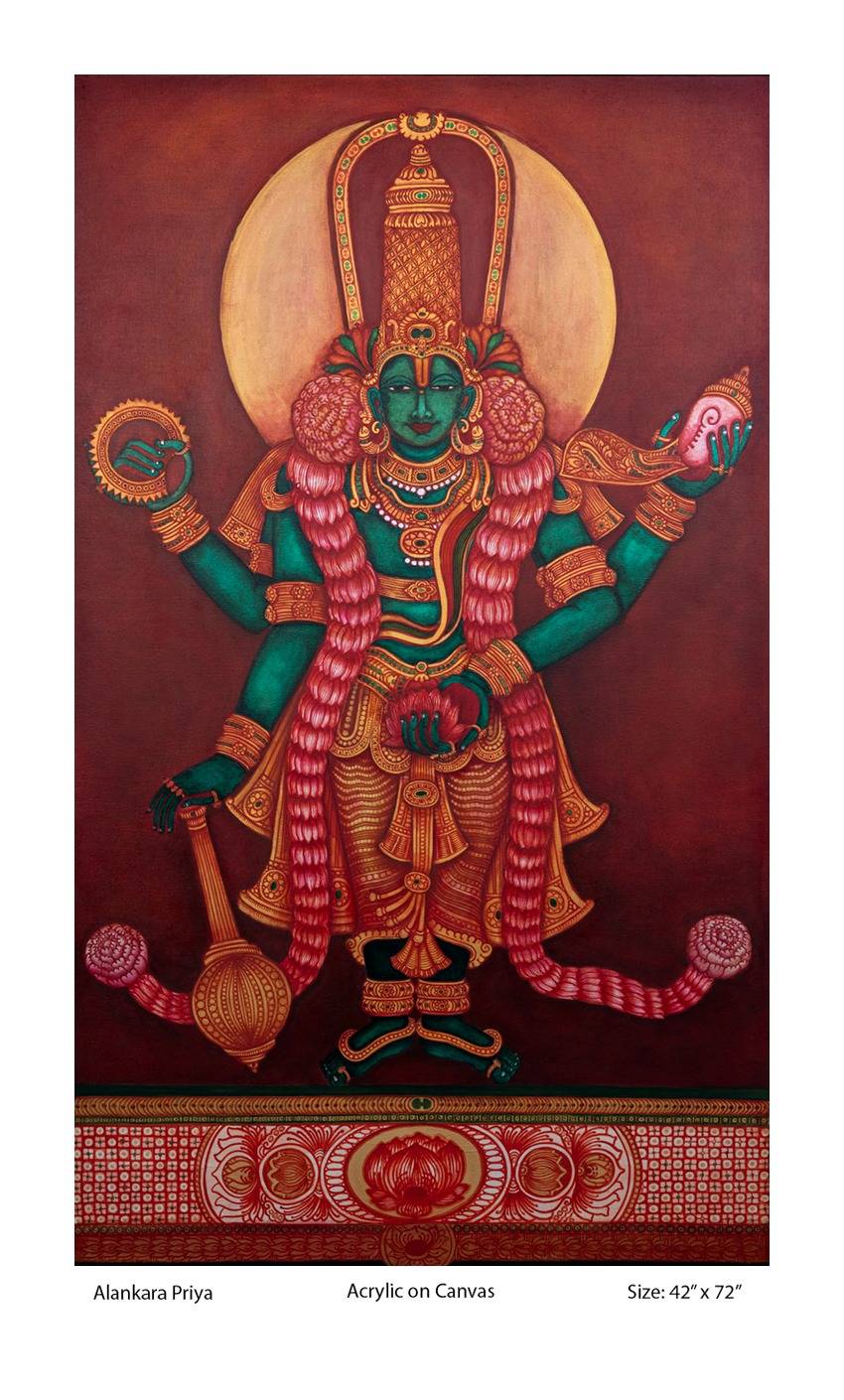
Alankara Priya
‘Alaṃkārapriyo Viṣṇur’: Vishnu’s love for adornment emphasizes the importance of beauty, devotion and purity of the spiritual journey, and affirms his role as protector of the universe. He is often depicted wearing elaborate garlands, divine jewelry and sacred ornaments. The lotus garland, Kaoustubha Mani, Vijayanthi Mala, along with his attributes – the Shanka, Chakra and Gadha – not only enhance his majestic presence, but also symbolize the deep devotion and love of his devotees, reflecting their reverence for his grace and power.
Vishwam
Arpitha says, “Vishwam is Vishnu, and Vishnu is Vishvam emphasizes that Lord Vishnu is the embodiment of the universe and His omnipresent presence.
Vishnu’s hands and symbols
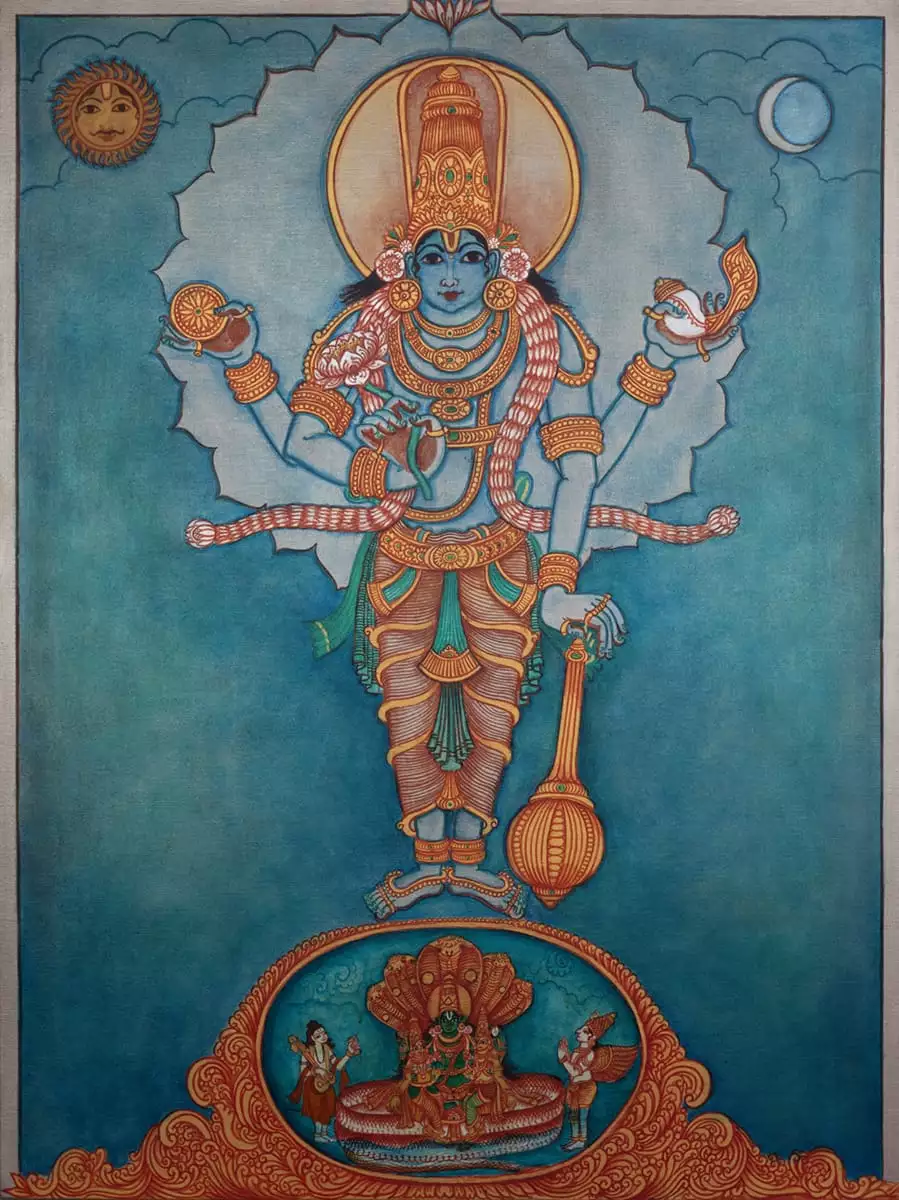
Vishnu’s four hands hold the shanka, the lotus, the chakra and the club. The shankha, or conch shell, is one of its main features. It symbolizes purity, brilliance, auspicious beginnings and shine. It also represents the five elements of the panchatatva. It is said that the shankha originated when gods churned the ocean and Lord Vishnu adopted it as a weapon. It is known to cleanse the soul and environment of negative energies, protect it from evil spirits. The shankha is called Panchajanya, which means ‘five elements’. When blown, the shankha produces the primal sound of creation.
Chakra
Lord Vishnu holds the Sudarshan Chakra. The word is formed from “Su” and “Darshan”, while Su means auspicious, Darshan means Vision. The Sudarshan Chakra is the divine disk of Lord Vishnu and is held in his right index finger. It protects those who are righteous and destroys evil forces. It restores law and order to the world. It provides protection against negativity and blesses people with spiritual well-being.
Mace (gada)
On the other hand, Lord Vishnu holds the Kaumodaki, the mace (gada), which means the ‘prisoner of the mind’.
Lotus
Lord Vishnu also holds the lotus flower, a symbol of purity, transcendence and dharma, or cosmic law.
Lord Vishnu is generally depicted holding the lotus in his lower left hand. A Shaiva myth describes Vishnu’s worship of Shiva with 1008 lotus flowers, offering one for each of his invectives.
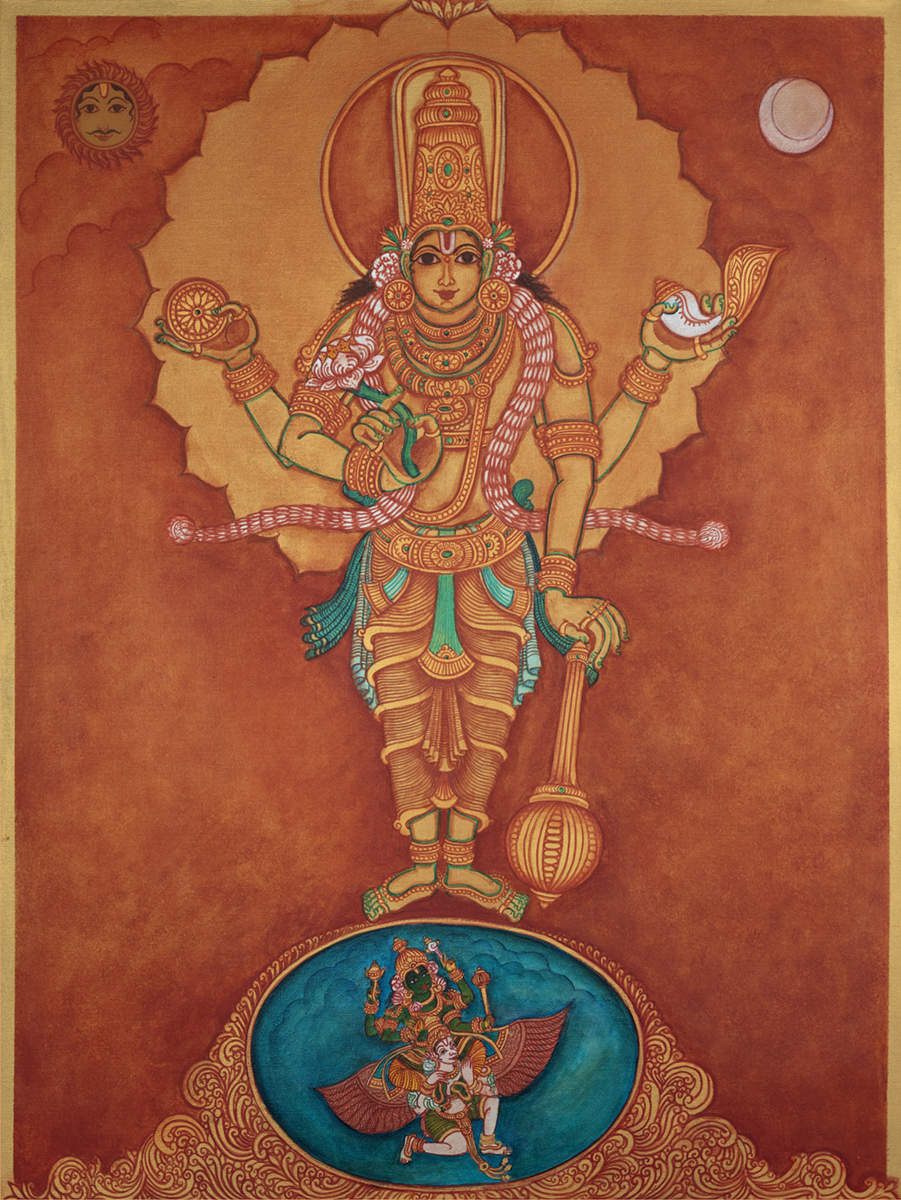
Swayambhu:
Vishnu manifests Himself by His own will and incarnates from time to time to restore Dharma and guide humanity.
As stated in the Bhagavad Gita:
(Paritrāṇāya sādhūnāṁ vināśhāya cha duṣhkṛitām dharma-sansthāpanārthāya sambhavāmi yuge yuge)
“For the protection of the good and the destruction of the wicked and the establishment of Dharma.”
Vishwam focuses on the omnipresent nature of Vishnu. Vishnu is the most important and powerful deity – the great protector, who conquers those who try to destroy the balance of the universe. Its form exhibits divine qualities, embellished with beautiful streamers and radiant colors, integrating lyrical and linear elements into the composition.
Fl. Vishnu’s color green symbolizes his role as a sustainer of life and sustainer of the cosmos in the rhythms of the universe.
Color and shapes
In these images we are reminded of both wood carvings and murals, symbolized by the figures of gods and goddesses with the elements of nature and associated lotus blossoms. Color and contour are both essential parts of these works, and we look at the love for the human figure. The colors that orchestrate both the images and the expression range from soft to dark tones to create multiple intensities. We can imagine these gods having sunk into relief patterns over the years, we can also imagine them rising from faded frescoes. Outlines and contours are Arpitha’s bliss with flow and passion. We can imagine the twilight hours when the beautiful Indian Summer casts its shadows on the temple ramparts. Arpitha plays with both horizontal and vertical registers to create her gods.
Rasa and Raga both feature in the iconic images that stimulate our senses. It is the multiple folds in the clothing, the traditional idiom of the folds of the dhoti or the saris that contribute to the touch of rasa in these works. The raaga is one that plays to our inner instincts as we imagine the kritis of Thyagaraja, while Balamurlikrishna sings in his impeccable baritone along the beaches of South India. This Vishwam exhibition is a universe in verse, it salutes the great poet Thiruvalluvar and his many texts in praise of the gods.
Arpitha Reddy’s Vishwam continues her odyssey into the depths and mystery of the universe in the verses of Indian antiquity found in the Bhagvada Puranas.
Arpitha Reddy Studio
Facebook
Tweet
Linkedin
E-mail
Disclaimer
The opinions expressed above are those of the author.
END ARTICLE